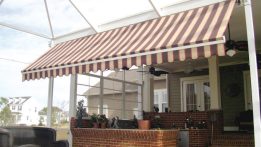Florida’s most sought after retirement home is not just for humans. At the Big Cat Rescue in Tampa, big cats retire in complete comfort. As seen on CNN, Animal Planet and the Discovery Channel, to mention a few. This 55 acre accredited sanctuary is home to more than 100 big cats representing 13 species. These are not your typical alley cats, they include lions, tigers, bobcats and lynx. Celebrating its 21st anniversary, BCR houses abandoned, abused, orphaned and retired big cats and saves them from extinction.
We met Jeff Kremer and Susan Bass upon our arrival at the BCR and felt like family immediately. They are both Directors and have spent many years at the rescue. I have been to several “rescue” facilities and left no question unasked on this particular visit. Jeff’s motto is, “good people make the best decisions when empowered with information and education” and education is what we received.
We began our tour meeting with Carole Baskin, Founder and CEO of the sanctuary. She manages 100+ volunteers, several interns from around the world, and 10 staff members and has run the Big Cat Rescue in Tampa since 1992. While taking no salary, her mission is to end trade in exotic cats. You can actually go online today and find everything from jaguars to tigers for sale. The major problem is that large cats are like “kittens” in their youth setting up the owner for a huge surprise when “the wild comes out” around age three years old. Carole stated that, even in the wild, parents and cubs fight to the death over territory, so how can we expect them to do differently in captivity? “It is in their blood and it cannot be trained out forever!”
Carole founded the Rescue and continues to rescue more big cats because of the large number of unwanted and abandoned cats in this country. Breeders convince naive people that cute cuddly cubs make good pets, but once the cats become large and dangerous, owners can no longer control or care for them.
These are some of the most egregious issues that harm big cats:
Petting Lion and Tiger Cubs
While some exhibitors claim they are teaching people not to get exotic animals as pets, others actively promote the trade. But all of them, by their behavior, encourage people to own exotic animals in order to be one of the “special” people who can have contact with these animals.
Lion Meat
Lion tacos go for $35, in case you were curious. The new fare also raises concerns about where this meat is coming from and how safe it might be. The FDA doesn’t inspect lion meat, and one of the potential origins for it may be the unknown number of lions living in “backyard pens, roadside zoos and other less-than-desirable circumstances” here in the United States. Without more information, it’s impossible to know the condition of such animals, which means the adventurous sampler of lion skewers, could be eating meat from ill or heavily medicated lions. Basically, there’s nothing good about lions on the menu. Scientific American
Big Cat Exhibitions
Whenever you see lions, tigers or other big cats on exhibit, take a moment to think about what it means to the cat. Big cats are hard wired to roam hundreds of miles and to be at the top of the food chain. It is cruel to confine them for the purpose of charging people to see an animal up close that would never allow you to get near them in the wild.
Exotic Cats as Pets
Pound for pound, big cats are 12 times stronger than a man, so when they have contact with people, even in play, the results are often tragic. Big cats grow fast and quickly become the hard wired killers they were designed to be. After the novelty of owning a big cat wears off and you no longer want it, nobody will take your big cat. You’ll be left with an animal you can’t get rid of that costs you thousands of dollars each year to properly maintain. Feel free to watch the videos on BigCatRescue.org: Tigers among Us~~~ is there a tiger next door? ~~~Why Regulations Don’t Work and Big Cat Bans are needed.
Note: There are more Tigers in the U.S. than wild in the rest of the world and most of them are in private homes in Texas.
Big Cats in Zoos
Zoos that are accredited by the Association of Zoo & Aquariums (AZA) have done a good job of convincing the public that they are the arks of the future and they manage their captive populations through a breeding program called the Species Survival Plan or (SSP.) Most AZA zoos only make token donations to protecting exotic cats in the wild and almost none of the non-accredited zoos send any of the money they make to protecting habitat. Even AZA zoos have been caught selling last year’s babies out the back door to brokers who sell them as pets and props.
The Global Federation of Sanctuaries, which sets standards for accredited sanctuaries, requires a minimum of 1,200 square feet of space for a big cat enclosure to be humane. That is six times the Florida legal minimum. In addition to being small, these legal cages usually have concrete floors. But being on the hard surface is detrimental to the feet and bones of the cats. No compassionate human being could look at two tigers kept in a concrete, chain link cage the size of a parking space and ever conclude this is humane treatment of an intelligent, sentient being that needs mental stimulation and is built to roam and hunt.
Note: There is currently no program that returns big cats to the wild.
BCR’S Past, Present and Future
“Big Cat Rescue did not start out as what it has become today. My beliefs, and the sanctuary that reflects them, evolved over time. It involved lessons that came from what I view today as horrible mistakes, and sometimes I feel terrible about how long some realizations took. But I take great pride in what we have become and are accomplishing, and feel great excitement about what I believe we will accomplish in the future.” Carole Baskin, Founder.
BCR is an GFAS-accredited sanctuary, which means they do not buy or sell big cats. They are a no-touch facility, which means there is absolutely no direct touching of any big cat and they are not taken off property for events.
In the past 20 years BCR has rescued more than 250 exotic cats and given them a permanent home in Florida. They have provided rehab and released many native bobcats into the wild. Their intern program has become the model that other top sanctuaries use for recruiting and training.
Celebrities of Big Cat Rescue
Big Cat Rescue has had the honor of being visited by and/or working with a number of big name celebrities including Bo Derek, Harrison Ford, Leonardo DeCaprio, Jane Goodall, Kate Walsh, Barbara Niven, Jack Harris, Jim Fowler, Jack Hanna, Bill Murphy, Tippi Hedren, Tim Harrison, Arch Deal, Congresswoman Castor, athletes from the Tampa Bay Bucs, the Lightning, the New York Yankees, and the casts of Wicked, Mary Poppins and the Jersey Boys just to name a few.
Touring the Big Cat Rescue
You can feed your beastly appetite for adventure at Big Cat Rescue of Tampa, FL. The Big Cat Keeper Tour is the most exclusive behind the scenes experience you can find in the animal world that is respectful to the animals and safe for the guests. If you are an animal lover and want to see the inner workings of a real animal sanctuary, then this 2-hour experience is what you have been searching for. See and learn about a wide variety of big cats, and support a great cause at the same time.
The Keeper Tour includes:
Enrichment: You’ll make toys and treats for the cats to stimulate an animals’ activity level and watch as keeper hands out what you’ve made. Observe the animals’ reactions as they investigate their enrichment that you helped create for them.
Operant conditioning: You’ll witness a training session between the cats & keepers. During this activity you will accompany the keepers who will teach critical behaviors to one of our feline residents, such as go into lock out, stand up so we can observe the paws and underside, and much more!
History: You’ll learn the history behind the BCR’s furry friends and how they came to call Big Cat Rescue home. In addition, you will hear the story of why Big Cat Rescue was founded, as you take a guided mini tour of the 55 acre sanctuary.
On your exploration you will see many of the more than 100 exotic cats, including more than a dozen different species and sub species of exotic cats! Learn about where these great cats come from in the wild and what you can do to help their plight. You will join an exclusive group of adventure seekers and a few of the highly trained staff for an orientation that will prepare you for an afternoon of Behind the Scenes excitement!
Each Behind the Big Cat Scenes Keeper Tour is unique and different, so you never know fully what to expect, besides a roaring good time!
Other tours are also available with tickets starting at $29. Check out www.BigCat Rescue.org for all the details.
A special thanks to Carole, Susan and Jeff for an excellent tour introducing us to an incredible facility and to Scientific America for their contributions in this article. Please remember Jeff’s motto, “Good people make best decisions when empowered with information and education”. We should all be proud to have the Big Cat Rescue call Florida home. ![]()
By Dale Joyce










